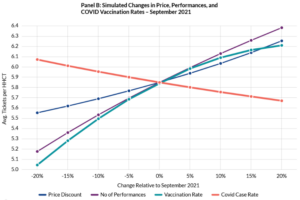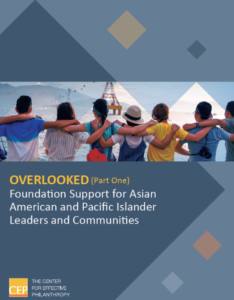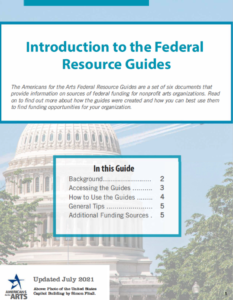February
2022
February 2, 2022
From the Field
Performing Arts Ticket Sales and Vaccination Rates
 SMU/DataArts has published a follow-up study on how vaccination rates may affect performing arts ticket sales through March 2022. When Will Arts Attendance Return? replicates a study that examined ticket sales data in 2021. This updated study examined 51 performing arts organizations across the country. It shows their ticket sales increasing as the pandemic eased and vaccination rates went up, with three models showing how sales of tickets could be expected to improve based on different vaccination rates.
SMU/DataArts has published a follow-up study on how vaccination rates may affect performing arts ticket sales through March 2022. When Will Arts Attendance Return? replicates a study that examined ticket sales data in 2021. This updated study examined 51 performing arts organizations across the country. It shows their ticket sales increasing as the pandemic eased and vaccination rates went up, with three models showing how sales of tickets could be expected to improve based on different vaccination rates.
Proof of Vaccination Required?
IMPACTS Experience has just published the results of a new a survey, Proof of Vaccination Requirements: Do Visitors to Cultural Entities Want Them? It shows the evolving attitudes of the public toward vaccination requirements for attending cultural events. 57% of adult Americans and 71% of likely visitors now believe cultural entities should require visitors to show proof of vaccination. This is up from 48% of likely visitors preferring vaccine requirements last September. A closer look reveals that 69% of visitors to exhibits want a vaccination requirement, while a higher 74% of visitors to performances want the same. The article stresses that organizations must consider multiple factors—of which this is one—when deciding on best practices for health and safety in their community.
Equity, Community Well-Being and the Arts
Social Cohesion that Promotes Equity and Well-Being through Arts and Culture: Guidance for Research is one of two PolicyLink memoranda to the WE-Making study of Metris Arts Consulting. (The WE-Making study shows how arts and culture help to unite communities and contribute to their well-being.) Supplementing the WE-Making resources with a focus on racial equity, this memorandum shows how the study’s concepts can be put into research practice and how they are relevant to policymakers. It draws on the perspectives expressed throughout the WE-Making study and the PolicyLink arts, culture and equitable development team’s reflection on community development, public health and the arts. Also included in this memo is a list of resources and networks that can aid in the research advancement of social cohesion through the arts.
Foundations Fall Short for Asian American and Pacific Islander Nonprofits
 The Center for Effective Philanthropy has published Overlooked, a two-part research series covering recent trends in Asian American and Pacific Islander (AAPI) and Native American nonprofit leaders and communities. Salient findings from parts One and Two conclude that, despite the heavy toll of the pandemic, few foundations have increased support for AAPI or Native American communities. Both before and during the pandemic, AAPI and Native American nonprofit leaders report having less positive experiences with foundation funders than do leaders of other races and ethnicities. These trends are not observed for communities of other races and ethnicities. Despite the hardships faced by AAPI and Native American communities, most foundations continue to overlook nonprofits that serve them.
The Center for Effective Philanthropy has published Overlooked, a two-part research series covering recent trends in Asian American and Pacific Islander (AAPI) and Native American nonprofit leaders and communities. Salient findings from parts One and Two conclude that, despite the heavy toll of the pandemic, few foundations have increased support for AAPI or Native American communities. Both before and during the pandemic, AAPI and Native American nonprofit leaders report having less positive experiences with foundation funders than do leaders of other races and ethnicities. These trends are not observed for communities of other races and ethnicities. Despite the hardships faced by AAPI and Native American communities, most foundations continue to overlook nonprofits that serve them.
Pandemic Support from Massachusetts Creative Youth Programs
Mass Cultural Council has published a new report, Carrying Community through COVID, on how its Creative Youth Development (CYD) programs adapted to the COVID-19 pandemic. The final reporting from more than 70 CYD organizations in fiscal years 2021 and 2022 shows that they played an integral role in their communities: serving as points of connection, pivoting to online learning services, and holistically supporting the basic needs of youth and their families. Looking ahead, CYD organizations expect to continue providing hybrid virtual programming, working toward greater diversity and racial equity, and supporting basic needs.
Guide to Communicating to Diverse Communities
 The Utah Division of Multicultural Affairs has produced a new guide, Communicating to Utah’s Culturally & Linguistically Diverse Communities. In a state where most population growth is racially and ethnically diverse, this guide is a tool for promoting equitable and inclusive language. While Utah-centric, the report provides useful recommendations for all public information officers, such as budgeting for accessibility and community liaisons, providing safe and brave spaces for community leaders, and prioritizing awareness of underrepresented communities. The guide also offers five priorities for getting started and additional questions that can assist with an initial organization evaluation.
The Utah Division of Multicultural Affairs has produced a new guide, Communicating to Utah’s Culturally & Linguistically Diverse Communities. In a state where most population growth is racially and ethnically diverse, this guide is a tool for promoting equitable and inclusive language. While Utah-centric, the report provides useful recommendations for all public information officers, such as budgeting for accessibility and community liaisons, providing safe and brave spaces for community leaders, and prioritizing awareness of underrepresented communities. The guide also offers five priorities for getting started and additional questions that can assist with an initial organization evaluation.
Updated Federal Resource Guides from AFTA
 Americans for the Arts (AFTA) has recently updated its series of Federal Resource Guides. The guides provide an overview of federal funding opportunities available for nonprofit arts organizations across six areas: community development, rural development, national service, congressional earmarks, environmental protection and economic development. Each resource also provides examples and case studies of arts organizations that have previously received pertinent federal funding as well as tips to support more successful applications.
Americans for the Arts (AFTA) has recently updated its series of Federal Resource Guides. The guides provide an overview of federal funding opportunities available for nonprofit arts organizations across six areas: community development, rural development, national service, congressional earmarks, environmental protection and economic development. Each resource also provides examples and case studies of arts organizations that have previously received pertinent federal funding as well as tips to support more successful applications.
In this Issue
From the President and CEO
State to State
- Massachusetts, North Carolina, Puerto Rico and Tennessee: Supplemental COVID-19 Relief
- New Hampshire: Arts in Health
- Wisconsin: Arts Challenge Initiative
Legislative Update
The Research Digest
Announcements and Resources
More Notes from NASAA
SubscribeSubscribe
×
To receive information regarding updates to our newslettter. Please fill out the form below.
